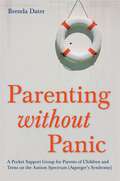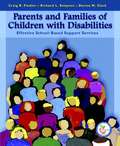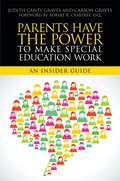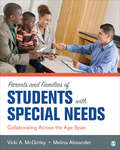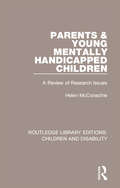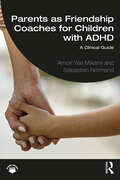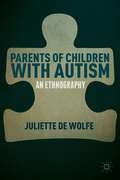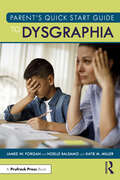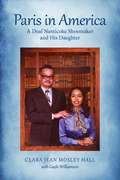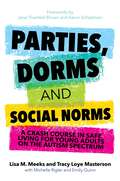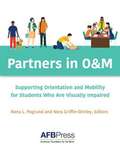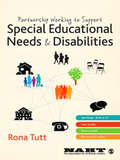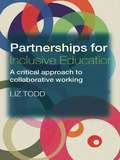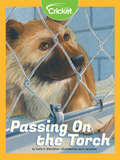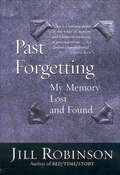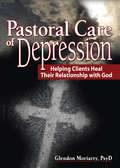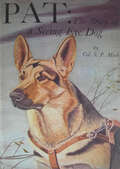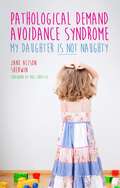- Table View
- List View
Parenting without Panic: A Pocket Support Group for Parents of Children and Teens on the Autism Spectrum (Asperger's Syndrome)
by Brenda DaterEver wish that parenting a child or teen on the autism spectrum came with instant access to a support group? Brenda Dater has provided parents with exactly that. In this book she draws on her extensive experience as a support group leader and parent of a child on the spectrum to offer trusted advice and tried-and-tested solutions to parents' top concerns, all in an accessible and easy-to-read format. Filled with the voices of other parents in the same situation, the book covers everything from the first steps to take after diagnosis, to advocacy and disclosure, behavior, building independence and resilience, making friends, holidays and vacations, homework, supporting siblings, how to garner support from extended family and friends, and how parents can look after their own wellbeing. This book extends the vital lifeline of a support group to parents of children and teens on the autism spectrum everywhere.
Parents And Families Of Children With Disabilities: Effective School-Based Support Services
by Richard L. Simpson Denise M. Clark Craig R. Fiedler Patricia J. Fewell William J. GibbsParents and Families of Children with Disabilities: Providing Effective School Based Support Services provides teachers and paraprofessionals with necessary motivation, research-based practices, skills, and resources to collaborate effectively wiith familes to develop family-centered schools. The book challenges educators to rethink the traditional roles and responsibilities of public schools, training teachers and paraprofessionals how to achieve effective stress management, child advocacy, and transition planning, as well as how to provide academic intervention for the families of children with disabilities and the diverse communities that surround them. General K-12 inservice teachers, paraprofessionals, and parents.
Parents Have the Power to Make Special Education Work: An Insider Guide
by Carson Graves Judith Canty GravesWritten by parents who have been through the US special education system, this book cuts through the jargon to provide other parents with a no-nonsense road map full of valuable first-hand insights and tried-and-tested advice. The authors clearly describe: · the special education process, including the school hierarchies parents are likely to encounter and etiquette to be aware of when dealing with school personnel · the information parents should expect to see in school evaluations and Individualized Education Programs (IEPs), and what to do when this information is missing or insufficient · problems parents may encounter when the needs of the school conflict with the needs of a child, including how to deal with such situations and when to seek legal advice · the importance of organizing special education documentation and establishing a 'paper trail', and how to begin this process · why transition planning is so important, and transition services parents may want to consider for their child. Demonstrating that parents really do have the power to make special education work for their child, this empowering guide is essential reading for parents of children with disabilities who are new to the special education system in the US, as well as those who feel frustrated with the system.
Parents and Families of Students With Special Needs: Collaborating Across the Age Span
by Dr Vicki A. McGinley Dr Melina AlexanderParents and Families of Students With Special Needs: Collaborating Across the Age Span teaches students the skills they need to effectively collaborate with parents and families to ensure a child's success in the classroom. Authors Vicki A. McGinley and Melina Alexander’s text takes a lifespan approach with a special emphasis on the critical transition points in a child’s life. Information is provided on what can be seen at each stage of an individual with disabilities’ development, and addresses concerns and needs that families may have during these unique phases of growth. Chapters written by professors and professionals who are also parents of students with special needs bring a diverse range of voices into the narrative. The authors provide an in-depth discussion of how parents and families are affected by particular disabilities, family system theory, the laws that affect individuals with disabilities, and assessments for individuals with disabilities.
Parents and Families of Students With Special Needs: Collaborating Across the Age Span
by Dr Vicki A. McGinley Dr Melina AlexanderParents and Families of Students With Special Needs: Collaborating Across the Age Span teaches students the skills they need to effectively collaborate with parents and families to ensure a child's success in the classroom. Authors Vicki A. McGinley and Melina Alexander’s text takes a lifespan approach with a special emphasis on the critical transition points in a child’s life. Information is provided on what can be seen at each stage of an individual with disabilities’ development, and addresses concerns and needs that families may have during these unique phases of growth. Chapters written by professors and professionals who are also parents of students with special needs bring a diverse range of voices into the narrative. The authors provide an in-depth discussion of how parents and families are affected by particular disabilities, family system theory, the laws that affect individuals with disabilities, and assessments for individuals with disabilities.
Parents and Professionals Partnering for Children With Disabilities: A Dance That Matters
by Janice M. Fialka Arlene K. Feldman Karen C. MikusCultivate effective partnerships between parents and professionals Written from both the parent’s and the professional’s points of view, this book draws upon the metaphor of dance to highlight the essential partnership between teachers, administrators, support staff, and parents of children with disabilities. Rich with humor and heart, the book offers helpful steps for self reflection, personnel preparation, and parent-professional training. Key features include: Practical insights and evidence-based approaches to forming partnerships Easy-to-read, non-technical language that speaks to both the heart and the mind Sample letters, conversations, and other forms of communication between professionals and parents Effective ways to handle difficult situations
Parents and Young Mentally Handicapped Children: A Review of Research Issues (Routledge Library Editions: Children and Disability #10)
by Helen McConachieFirst published in 1986, this book reviews research on the role parents play in fostering the early development of children with mental handicaps. Professionals and parents must work together to give such children the chance of living as ordinary lives as possible and here, the author develops a broadly-based conceptual framework for the involvement of parents as teachers of their young handicapped children. McConachie identifies characteristics of parents which seem of particular relevance to the design and success of intervention programmes. Although written in the 1980s, this book discusses topics that are still important today.
Parents as Educators (Routledge Library Editions: Home and School)
by Keith J. ToppingModern practice in the 1980s was to involve parents increasingly in the education of their children, and was supported by legislation. Particularly when children had special needs, parents required structured training and support to ensure they affectively sustained their vital role as educators at home. Many large-scale programmes to provide this had been developed throughout the world at the time, for example, Home Start, Portage Home Visiting Projects and Paired Reading Projects.However, not all of these had been thoroughly evaluated, and the existing literature was scattered and difficult to access. Some projects demonstrated spectacular results and high cost-effectiveness, while others proved more disappointing. Originally published in 1986, this book critically analyses over 600 international English-language research reports on the effectiveness of parent training programmes. In addition, a detailed guide to the practicalities of planning projects is provided, together with a comprehensive directory of useful resource materials.After an introductory overview, the evidence on the effects on child progress of parental involvement in school activities is reviewed, as is research on the impact of schemes of regular structured communication between home and school. Programmes designed to train parents to accelerate the development of their children at home are considered in the subsequent chapters, starting with “ordinary” children. Much of the book reviews projects targeted on children with some sort of special educational need, from children whose special needs stem from a widespread difficulty such as poverty or second language learning, systematically through to children whose needs stem from rarer and more severe issues. Each chapter has its own summary for ease of reader use, while an overall summary chapter points out “best buys” and directions for future developments.This volume will be of major interest to teachers, psychologists, social workers, community health personnel, community educationalists, researchers, many others working with parents and children, and to some parents themselves.This book is a re-issue originally published in 1986. The language used is a reflection of its era and no offence is meant by the Publishers to any reader by this re-publication.
Parents as Friendship Coaches for Children with ADHD: A Clinical Guide
by Amori Yee Mikami Sébastien NormandThis book introduces Parental Friendship Coaching (PFC), an intervention that parents can use to support peer relationships in their elementary school-aged children with ADHD. In the PFC program, clinicians work with parents to coach their children with ADHD in friendship behaviors that help develop and maintain high-quality relationships. Featuring 10 research-based clinical sessions, the book provides detailed, step-by-step instructions for clinicians about intervention provision. Each session includes skills teaching devoted to supporting children’s peer relationships, activities to practice the skills in session, problem-solving about difficulties carrying out the skills, and homework to try the skills at home. This book also includes handouts for parents and clinicians, tips for clinicians about addressing common parent difficulties, and suggestions for progress monitoring. Intended for mental health professionals working with families of children with ADHD and peer problems, this book will aid clinicians in educating parents on how to support their children’s friendship development.
Parents of Children with Autism
by Juliette De WolfeIn a readable and highly accessible ethnographic account that is shaped by the stories of families and the voices of parents, De Wolfe examines how parents of children with autism navigate the educational and medical systems, understand their own and their children's bodies, and support and educate one another.
Parent’s Quick Start Guide to Dysgraphia
by James W. Forgan Noelle BalsamoParent’s Quick Start Guide to Dysgraphia provides parents and caregivers with an immediate overview of dysgraphia and steps they can take to support and encourage their child. Each chapter is packed with detailed and helpful information, covering identification, strategies for improvement, advocating for your child, and maintaining your child’s self-esteem. Summary and resource sections at the end of each chapter give quick guidance to busy readers. Topics include a wealth of research-backed activities, strategies for improving penmanship, making writing fun, technological assistance, and more. Offering straightforward, easy to understand, and evidence-based information, this book is a go-to resource for caregivers parenting a child with dysgraphia.
Parent’s Quick Start Guide to Dyslexia
by James W. Forgan Noelle BalsamoParent’s Quick Start Guide to Dyslexia provides parents and caregivers with an immediate overview of dyslexia and steps they can take to support and encourage their child. Each chapter is packed with detailed and helpful information, covering identification, public schools versus private settings, and how (and when) to seek professional help. Summary and resource sections at the end of each chapter give quick guidance to busy readers. Topics include a wealth of research-backed activities, nurturing talent and creativity, motivating your child to read, and more. Offering straightforward, easy to understand, and evidence-based information, this book is a go-to resource for caregivers parenting a child with dyslexia.
Paris in America: A Deaf Nanticoke Shoemaker and His Daughter
by Clara Jean Hall Gayle WilliamsonClara Jean Mosley Hall has inhabited various cultural worlds in her life: Native American, African American, Deaf, and hearing. The hearing daughter of a Deaf Nanticoke Indian, who grew up in Dover, Delaware’s black community in the 1950s and 60s, Hall describes the intersections of these identities in Paris in America. By sharing her father’s experiences and relating her own struggles and successes, Hall honors her father’s legacy of hard work and perseverance and reveals the complexities of her own unique background. Hall was abandoned by her Deaf African-American mother at a young age and forged a close bond with her father, James Paris Mosley, who communicated with her in American Sign Language. Although his family was American Indian, they—like many other Nanticoke Indians of that region—had assimilated over time into Dover’s black community. Hall vividly recounts the social and cultural elements that shaped her, from Jim Crow to the forced integration of public schools, to JFK and Motown. As a CODA (Child of Deaf Adults) in a time when no accessibility or interpreting services were available, she was her father’s sole means of communication with the hearing world, a heavy responsibility for a child. After her turbulent teenage years, and with the encouragement of her future husband, she attended college and discovered that her skills as a fluent ASL user were a valuable asset in the field of education. Hall went on to become a college professor, mentor, philanthropist, and advocate for Deaf students from diverse backgrounds. Her memoir is a celebration of her family, her faith, her journey, and her heritage.
Participant Handbook - Data Entry Operator (Divyangjan)
by Skill Council for Persons with DisabilityThe Participant Handbook - Data Entry Operator (Divyangjan) is a comprehensive guide designed to provide skill-based training for individuals with disabilities, focusing on the role of Domestic Data Entry Operators within the IT-ITeS sector. It aligns with the National Occupational Standards and offers structured learning through a modular approach. Covering essential aspects like data entry processes, software requirements, troubleshooting, and employability skills, the handbook emphasizes accuracy, professionalism, and error mitigation in data handling. It also incorporates guidelines for leveraging automation technologies such as OCR and AI to enhance efficiency, while addressing the unique needs of participants through tailored content for various disabilities.
Parties, Dorms and Social Norms: A Crash Course in Safe Living for Young Adults on the Autism Spectrum
by Lisa M. Meeks Emily Quinn Tracy Loye Masterson Amy Rutherford Aaron Schatzman Jane Thierfeld-Brown Michelle RiglerThe late teens and twenties are exciting times, but filled with potential pitfalls as young people navigate the transition into independent adult life. This handbook is filled with the information that young people with ASD say they want (and need) to know about alcohol and drugs, social media and online safety, relationship types and boundaries, safe sex, stress and emotional health, and independent living. It includes real life examples, coping strategies and practical tips to help young adults with ASD stay safe while living life to the full. Informal and frank, this will be a go-to guide for young people on the autism spectrum.
Partners in O&M: Supporting Orientation and Mobility for Students Who Are Visually Impaired
by Rona L. Pogrund Nora Griffin-ShirleyPartners in O&M: Supporting Orientation and Mobility for Students Who Are Visually Impaired is a comprehensive text that serves as an introduction to the field of O&M, with a focus on professionals who work in collaboration with O&M specialists to support O&M instruction for students who are blind or visually impaired.
Partnership Working to Support Special Educational Needs & Disabilities
by Dr Rona TuttIn order to achieve the best outcomes for all children and young people, schools must work in partnership with students, parents, other professionals and the wider community. In this changing landscape of education, the notion of the traditional school is fast disappearing. This book looks at what is possible in this exciting new world, and how some teachers and other professionals are putting into practice the best principles of multi-agency working. Finding innovative ways of supporting children and young people with special educational needs and disabilities (SEND) in this context is more important than ever, as children are being diagnosed with increasingly complex needs. Those working with children need to be aware of the fresh opportunities that are opening up and which can help every individual to maximise their full potential. This book examines how partnership working affects children with SEND by considering: - the diversity of additional needs; - the role of specialist schools that have an SEN specialism; - partnership working between mainstream and special schools; - partnership working with groups of schools, including those that are co-located or federated; - the growth of academies and trust schools; - schools and other services working together; - the work of extended schools and children's centres; - a wide range of other services for children, young people and families. Filled with case studies of effective practice from real schools and services, this book is a must-have for those looking at how to work together to achieve positive outcomes for all. Rona Tutt OBE is a Past President of the National Association of Head Teachers (NAHT) and works as a consultant, writer and researcher on all matters relating to education in general, and special educational needs and disabilities in particular.
Partnerships for Inclusive Education: A Critical Approach to Collaborative Working
by Liz ToddShortlisted for the NASEN/TES 2007 Book Award Increased partnership between professionals, particularly through the integration of services, indicates a major opportunity for child and parent participation, but one that seems in danger of being side-stepped. Drawing on substantial research evidence, this book looks at reasons for this situation; what is happening now, what developments and initiatives have been tried and what can be done to develop a culture of participation? Some of the main threats to participation are discussed in this book including: Has ‘partnership’ ever been? Who is excluded from 'partnership'? Which discourses have made participation illusive and what are the implications – theoretical and practical - for how we move forward? Partnerships for Inclusive Education includes a helpful framework map which guides critical thinking towards the development of a culture of collaboration and presents original and stimulating ideas to open up the complex processes that can frustrate participative practice. Combining socio-cultural ideas with post-structural thinking gives this book a strong yet accessible theoretical basis, making it a valuable resource to both an academic and a professional educational audience.
Passing On the Torch
by Claire H. BlatchfordWhen Ginger, a hearing-ear dog, begins to go deaf herself, her owner must find another dog to help them both. Her owner pays a visit to the pound and finds Leo! Will he be able to help them hear?
Passing the Special Education TExES Exam: Keys to Certification and Exceptional Learners
by Elaine L. WilmoreGain confidence, lower stress, and raise your TExES exam scores! In this artful guide, TExES test prep veteran Elaine Wilmore breaks down the EC-12 and Supplemental special education test so you can feel calm and confident on test day. Built on her successful test-prep training seminars, she shows how to think like the test was developed and covers: Each special education domain and competency Philosophies behind the test questions Teaching stories that improve answer recall Tips for analyzing test questions Ways to use key words and concepts to improve test results Techniques for in-state and out-of-state test takers
Past Forgetting: My Memory Lost and Found
by Jill RobinsonA love story, a mystery, and a memory guide, Past Forgetting shows a writer's determination to re-create her life.Jill Robinson, novelist and author of Bed/Time/Story, wakes from a coma to discover she's lost her memory and just about any sense of who she was.And is.She likes the look of the man standing next to her bed, but doesn't recognize that he's her husband, Stuart. What matters is that she feels safe around him. As she searches the house for her children, she is reminded that her son and daughter are both grown with families of their own--how well did she ever know them? Can You make up for a past you don't really remember?It is Stuart who begins to fill in the details for Jill, including the fact that she's a well-known writer, although when she meets with her doctors, they say she may never write again.Against all odds, Jill Robinson retrieved her unique writing voice, and in this engaging memoir shows how she does it. She takes us with her on her exploration of'tlie connections between memory and creativity, celebrity and anonymity, and loss and discovery. From her first tentative steps outside her house on Wimpole Street to London's sleek West End. From a trip to Oxford to discuss memory with a professor to her amazing voyage to Los Angeles on an assignment for Vanity fair which takes her back to the sixties world of Hockney, Polanski, and Hopper, Jill forges new paths to memory.In Past Forgetting, Jill Robinson rediscovers friendships she doesn't know she had: Robert Redford tells her stories about her childhood; at John Lahr's London literary teas, she's reintroduced to the writer's world, and Cary Grant offers her memories of her father, Dore Schary. And being with Barbra Streisand reminds her of a time she doesn't quite remember: when her father was running MGM.In her urgent voyage to redefine herself, Jill asks all the questions you've ever asked on the nature of memory. Is recollection shadowed by emotion? Is memory an act of reinvention? Do people reinvent rather than recollect? In Past Forgetting you'll find the answers and you'll meet a writer you won't want to forget.
Pastoral Care of Depression: Helping Clients Heal Their Relationship with God
by Glendon MoriartyThis book provides the essential tools needed to transform negative God images in depressed clients! Pastoral Care of Depression: Helping Clients Heal Their Relationship with God is designed to help clergy and mental health professionals understand how depression negatively affects the way people emotionally experience God and how, through therapy, this hurtful God image can be changed into a much more positive one focused on healing.In the past, the God image (as well as the essential differentiation between God image and God concept) has been explained in dull, analytic terms that are difficult to understand. This book&’s jargon-free language and engaging presentation make it an effective learning tool for students and professionals alike. Inside, you&’ll find numerous psychological tests, complete with sample test forms, that identify the God image. These are clearly explained and include all the information needed to take, administer, and interpret them. Pastoral Care of Depression teaches you to use psychodynamic and cognitive interventions to change a client&’s God image, including foundational knowledge and clearly presented techniques to implement in the therapeutic relationship. This comprehensive treatment manual arms you with the most comprehensive array of cognitive interventions published to date, with tens of easy-to-follow techniques designed to tap directly into an individual&’s subjective experience of God. Two appendixes give you a sample God Image Automatic Thought Record and Treatment Plan form.Part I: Depression and the God Image examines: the nature and development of depression symptoms of depression specific to religious people defining a client&’s image of God, how it developed, and what it reveals the relationship between self, depression, and God image, and how God images relate to Christian thoughtPart II: Changing the God Image addresses: the importance of self-evaluation for therapists and counselors-and how to do it the nature of the therapeutic relationship counseling skills that strengthen the therapeutic relationship how to conduct an God Image Assessment Interview and how to work with what that interview reveals transference, countertransference, cyclical maladaptive patterns, and internalization in psychodynamic psychotherapy appropriate, effective psychodynamic interventions the essentials of cognitive therapy and how it can be utilized to positively affect the God image treatment planning and case conceptualization important ethical issues for considerationWith well-designed test and exercise forms and clear instructions on their use and interpretation, Pastoral Care of Depression provides the essential tools needed to work effectively with this important client group. Make it a part of your professional/teaching collection today!
Pastoral Care with handicapped Persons
by Lowell G. ColstonDescribes the role pastors play in the lives of people with disabilities.
Pat: The Story of a Seeing Eye Dog
by S. P. MeekWhen Jimmy is attacked by a Japanese soldier in the Pacific during World War II, his devoted signal dog Pat, dies defending him. After Jimmy returns to the states, totally blind, he falls into despair until his fiancé encourages him to apply for a guide dog. Jimmy goes to The Seeing Eye and trains with Pat, a beautiful German Shepherd. Life goes on for the two until one night, when Pat helps save the day during a horrible hurricane. Themes about losing vision, dealing with overprotective family members, and the freedom you can receive by working with a guide dog are all interwoven into the plot.
Pathological Demand Avoidance Syndrome - My Daughter is Not Naughty
by Phil Christie Ruth Fidler Jane Alison SherwinJane Alison Sherwin's honest and uplifting account provides insight into the challenges of bringing up a child with Pathological Demand Avoidance (PDA). After years of misdiagnosis, Jane's daughter, Mollie, was diagnosed with PDA at the age of seven, and we follow her experiences pre and post diagnosis to age 10 as she attends school, interacts with the outside world and approaches adolescence. Throughout, Jane provides commentary on her daughter's behaviour and the impact it has on her family, explaining the 'why' of PDA traits, including the need for control, meltdowns, obsessive behaviour and sensory issues. She reveals the strategies that have worked for Mollie and provides essential advice and information on obtaining a diagnosis and raising awareness of PDA. The book also includes an interview with Mollie. Full of advice and support, and with a focus on understanding the child and how he or she sees the world, this book will be of immeasurable value to the parents and families of children with PDA as well as the professionals working with them, particularly teachers and teaching assistants, SEN co-ordinators, psychologists, outreach workers and social workers.
